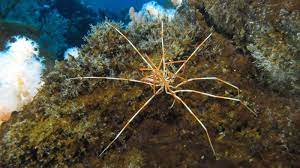Do you know about giant sea spiders? These living mysteries are usually only a few millimeters in size. However, in the Antarctic Sea, they can reach several tens of centimeters in width. Researchers at the University of Hawaii looked at this animal and discovered a very particular method of laying eggs.
Antarctica still conceals many mysteries. Among them, giant sea spiders, or pycnogonids. In most of the world’s oceans, these spiders measure no more than a few millimeters. On the contrary, in the Southern Ocean, they can reach a wingspan of 40 centimeters.
A study from the University of Hawaii, published on February 11 in the Ecological Society of America, takes a close look at these ocean giants. Specifically, research led by UH Mānoa School of Life Sciences professor Amy Moran focuses on “oviposition, post-oviposition behavior, and embryonic development of the common Antarctic giant sea spider, Colossendeis megalonyx,” specifies the study.
A discovery that had eluded researchers for more than 140 years
According to the World register of marine species (Worms), Colossendeis megalonyx was discovered in 1881. The species immediately attracted the attention of scientists. However, how this giant spider looked after its eggs remained unknown. “In most sea spiders, the male parent cares for the babies by carrying them around during their development. The strange thing is that, despite descriptions and research going back over 140 years, no one has ever seen the giant spiders of the Southern Ocean brooding their young and nothing was known about their development.” , explains Professor Moran in a press release.
To learn more, the researchers captured two groups of Colossendeis megalonyx and brought them back to the laboratory. “We were so lucky to witness this,” says Aaron Toh, a doctoral student in the School of Life Sciences. “The opportunity to work directly with these fantastic animals in Antarctica means we would have the opportunity to learn things no one would have ever guessed.” The researchers were then finally able to observe the behavior of these spiders towards their eggs.
A unique egg handling strategy
Unlike other species, “one parent (probably the father) spent two days attaching the eggs to the rocky bottom,” details the study. Then, “they developed there for several months before hatching into tiny larvae.” Graham Lobert, also a doctoral student at the School of Life Sciences, adds: “We could barely see…




